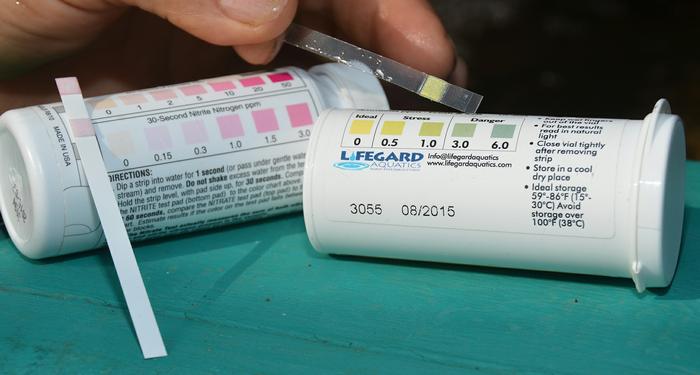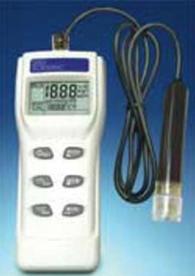Organic Aquaponic System Water Chemistry
1. Measurement Methods
We measure our water for: dissolved oxygen, measured with a digital DO meter that costs about $350 and is really accurate; nutrients (ammonia, nitrites/nitrates) measured with different test strips you dip in and then read the color, that cost about $0.50 each; and pH, measured with a digital pH meter that costs $140. The basic measurement kit for a commercial aquaponics operation costs about $600, then about $200/year after that for the strips, which are consumable.
(Below) Nitrite/Nitrate test strips (pink, to the left) and ammonia test strips on the right.
We check for iron deficiencies by looking for new plant growth that is yellowish between the veins on all the leaves, both new and older; this is easiest sign of iron deficiency to diagnose with. Using “iron test kits” and “maintaining specific measurable levels of iron” as some so-called experts say is totally unnecessary. You already have a built-in iron test kit, it’s called your eyeballs. When your plants look a bit yellow, they need iron; give them some and they’ll green up immediately (more in a bit on iron). You don’t need a meter for that.
2. What We Measure In Our Systems, And What It Means
Measuring DO (Dissolved Oxygen)
The most important water parameter we measure is DO (dissolved oxygen), which we measure with a DO meter; the one we like is the Sper Scientific part #850048 with a five-year warranty. If your DO is 7, that’s very good. If it’s 6 it’s good. If it’s 5 it’s decent. At 4 ppm you are OK but you should pay attention. If it’s 3 you are stressing your fish. At 2 ppm you have an immediate problem and need to solve it within the next thirty minutes or less. At 1 ppm DO you are killing fish, they’re just not floating yet. You’ll notice there’s a problem when they begin gasping at the surface after exertion (such as the feeding frenzy that happens when they are fed) and that’s not cute, it’s an indication that DO is low and your fish may be dying.
Get out your meter and find out what’s going on! You can get test strips for this also, but they cost $0.50 each, and aren’t very accurate. This motivates you to test less rather than more often. You can do thousands of tests with your own DO meter, and the more often you use it, the less each test costs you. The DO meter is an essential tool for frequently monitoring the DO of the water coming into and going out of your troughs; this is an indication of how well things will grow in your system.
If you built one of our standard systems with the exact parts list that came from the manual, and you haven’t changed ANYTHING, then you don’t need a meter. Your system will have good DO’s everywhere. But if you’ve changed anything for whatever reason, you need to be certain you are getting the DO levels your fish and plants need: get a DO meter and check!
(Below) A Sper Scientific DO meter, the accurate way to measure DO! |
The most important water parameter we measure is DO (dissolved oxygen), which we measure with a DO meter; the one we like is the Sper Scientific part #850048 with a five-year warranty. |
Measuring Ammonia, Nitrites, Nitrates, And Chlorine/Chloramine
To measure ammonia, nitrites/nitrates, and chlorine/chloramine, we use simple commonly available test strips (brand names and suppliers are in the materials lists contained in the Construction Manual of this Training). They’re easy to use: just dip them in the water for the length of time specified in their instructions, then compare the color of the strip to the colors on the bottle. We’ll talk a lot more about water quality measurement, chlorine, and chloramines, in the section dealing with source water for your system.
Ammonia is measured from 0 to 6 ppm by the test strips. Above 6 is supposed to be toxic to the fish, but we think we had some of ours at much higher levels before we figured out how to fix it. Normal operating range for aquaponics systems is around .25 to 1.0 ppm ammonia. The same goes for nitrites: 6 ppm or over is toxic, normal operating range is .5 to 1.0 ppm. Nitrates are better tolerated by the fish, and operating range is 10-100 ppm, with toxic being between 500-1,000 ppm.
IMPORTANT! If you are operating an organic aquaponics system (this means NOT using any caustic bases for pH adjusters), then your nitrite and nitrate levels may appear so low that only test strips with a sensitive range can even show them. The test strip we suggest is Hach AquaChek 27454, available from Aquatic EcoSystems catalog # H27454. This strip has a nitrite scale from 0.15 ppm up to 5 ppm, and a nitrate scale from 1 ppm up to 20 ppm. If you use something else to test nitrites and nitrates, you MUST use a strip or test that can test at these levels of sensitivity, or you may think you have none!

Leave a Reply